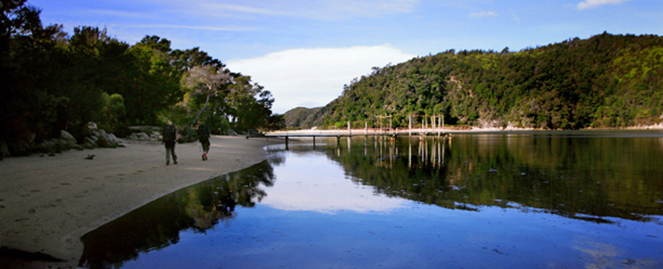
Virgin Islands National Park
USINFO | 2013-08-12 14:48

Trunk Bay Beach in Virgin Islands National Park, St. John
Gateway City: Charlotte Amalie
Nearest Airport: St Thomas Island Cyril E King Airport (STT)
Size: 14,688.87 acres
Date Founded: 1956
Annual Visitation: 677,289
Busiest Month: December-April
Average Temperature: Jan 77°F, July 83°F
Average Rainfall: 55"
Time is something to be ignored when visiting Virgin Islands National Park. Pay no attention to your wristwatch; better yet, don't wear one. Forget about trying to cram too many things into your visit. Instead, adjust to "island time" and go with the flow.
Virgin Islands National Park, renowned throughout the world for its breathtaking beauty, covers two-thirds of the 19-square-mile island of St. John and boasts some of the most beautiful coral reefs, plant life, and multicolored tropical fish in the Caribbean. Several beautiful beaches and 22 hiking trails are also included within the national park's boundaries. More than a third of the 11,560 acres that make up the national park are underwater, offering unparalleled diving and snorkeling. Thanks to the park, St. John's has sustained its vast stretches of green hillsides, exotic foliage, and pristine white-sand beaches.
To these amazing natural resources, add relics from the pre-Colombian Amerindian civilization, remains of the Danish colonial sugar plantations, and reminders of African slavery and the subsistence culture that followed during the 100 years after emancipation—all part of the rich cultural stew preserved by the Park.
Take a Dive
Leave the wetsuit at home; you won't need it for diving the warm waters off the coast of St. John. The Virgin Islands rank as one of the Caribbean's premier diving and snorkeling locations. And whether you want to don scuba gear or simply a snorkel and mask, the reefs framing the Virgin Islands National Park are awe inspiring for beginners and always eventful for more experienced divers. Congo Cay is a favorite dive site. It is a rocky islet located between St. John and St. Thomas. Visibility here is fabulous, allowing easy views of the coral mounds dense with sponges, fish, and, of course, coral!
Sail Cinnamon Bay
The Virgin Islands, with their superb reefs, beaches, and views make a premier boating destination. A good place to become an old salt is Cinnamon Bay, a shallow, open bay located adjacent to the National Park campground. It provides a convenient sports center that rents snorkel gear and windsurfers. You can also arrange day sailing, snorkeling, and scuba diving lessons and excursions. If the bay becomes a bit too busy, dock your boat and explore the old customs house along the beach, which is now a museum. Or follow a nature trail close to the campground and discover well-preserved sugar plantation ruins.
Snorkel Trunk Bay
Let's state the obvious—beautiful St. John's beaches are idyllic, and the clear turquoise waters are a fantasy come true for swimmers and snorkelers. The beach at Trunk Bay is one of the most beautiful in the world. Trunk Bay is one of the Caribbean's most photographed beaches, and features an underwater self-guiding snorkeling trail. The 225-yard trail is marked by underwater signs that identify coral reef life. It is a perfect place for easy swimming, and is especially good for families with young children.
Walk the Sugar Trail
St. Johns is not a huge place, and the trails don't cover a great distance—a couple miles at the most. But given those limitations, the hiking at Virgin Islands national park can be a diverse experience. Trails range from easy walks to difficult climbs, from well-maintained to brushy. Some of the best trails are in the wilder South Shore area. The Reef Bay Trail passes through a shady forest and a dry forest, taking in a beach and the ruins of four sugar plantations. One detour visits petroglyphs attributed to the Arawak Indians; another to wild Lameshur Bay. In the north, the Annaberg School Area offers a compact system around the ruins of one of the Caribbean's oldest public schools. The views and wildlife watching are superior here.
Look Out for Cuckoos
During the winter months, especially along the Francis Bay Trail, bird-watching is excellent—particularly for such species as the West Indian whistling-duck, yellow-billed cuckoo, and some of the more than 160 species known to these islands. A mangrove forest and brackish pond found on this trail provide lush habitat for our flying friends. More than 30 species of tropical birds breed on the island. They include the bananaquit, the black, parrot-like smooth-billed, and two species of Caribbean hummingbirds. Many warblers and other birds seen in the continental United States in the summer spend their winters in the dense forests.
Drive to Paradise
An easy morning or afternoon drive, considering the small size of the island, St. John's numerous roadside pullouts compete for the "best of the best" award; to island explorers, each panorama seems more spectacular than the last. The scent of bay rum trees at higher elevations such as Bordeaux Mountain, elevation 1,277 feet, recalls an era when the leaves were harvested to produce St. John's famous Bay Rum Oil. While atop Bordeaux Mountain, the Reef Bay Sugar Mill and Great House are great stops along the drive. Also not to be missed are the breathtaking views of the British Virgin Islands from Centerline Road (Route 10).
Virgin Islands National Park
1300 Cruz Bay Creek St. John, VI 00830 340-776-6201 www.nps.gov/viis
Share this page



















